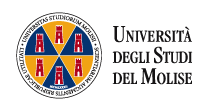Biochemical pathways to NAD plus, a multi-faceted metabolite, in COVID19 Pandemic novel era
Maria Luigia Pallotta*,1
1DEPARTMENT OF Medicine and Health Sciences “Vincenzo Tiberio”, University of Molise, 86100 Campobasso Italy
*Maria Luigia PallottaCORRESPONDING AUTHOR: pallotta@unimol.it
Considering NAD+ a compound with multitasking functions, insight into “the NAD+ World 3.0”, can implement issue on cellular energy level and as potential marker for healthy status. Nicotinamide/nicotinic acid mononucleotide adenylyltransferase (NMNAT) has long been known as the master enzyme in NAD+ biosynthesis in all eukariotes. NMNAT appears to be a multifunctional enzyme that sits both at the core of central metabolism and at a crossroads of multiple cellular processes. NMN is bioactive nucleotide which is naturally found in disparate foods a physiologically relevant amount and NMN might be absorbed/synthesised also from microbiota in our body and thus help sustain NAD+ biosynthesis, together with ATP via NMNAT isoformes through a single reaction NMN+ATP↔ 𝑁𝐴𝐷++ 𝑃𝑃𝑖. Lately it was identified the transporter for NMN (Slc12a8), improving to clarify how mammals absorb and manufacture NAD+. In yeast mitochondria, pre-eminently microbial cell factory & the simplest eucaryotic cell, NAD+ biosynthesis and catabolism is far to be explained. In Saccharomyces cerevisiae, the nicotinate moiety of NAD+ can be generated by kynureinine pathway that requires oxygen at three steps. Thus, this paper describes pre-clinical and in vitro experiments by means of Saccharomyces cerevisiae with different phenotypic landscape in which cell vitality, NAD(P)+/NAD(P)H pool and adenylate compounds were determined in spectrofluorimeter microplater reader and via HPLC as reported in references that follow. Further, NMN was added to crude mitochondria isolated starting from cell grown aerobically and under glucose limitation and bioenergetics -ICR, ΔΨ and key physiological parameter (i.e. Adenylate Energy Charge and Adenylate pools- were measured by means of polarographyc, HPLC and fluorimetric assays). Findings showed significant difference in the intramitochondrial purine nucleotides profile, consequently I can claim that in my experimental environment, in bona fides(a), NMN uptake influences {Energetic Charge =[ATP]+ ½ [ADP]/[ATP] +[ADP]+[AMP] } and could emerge as a central hub between bioenergetics and Pi homeostasis with implications for therapeutic strategies of NAD+ supplementation in disease treatment particularly in COVID-19 pandemic time where the SARS-CoV-2 has resulted in a devastating threat to human society in terms of health, economy, and lifestyle [3] The Italian Governmentby means of Giuseppe Conte introduced progressive mitigation measurements on March 9 and March 11, 2020, to drastically limit social interactions and prevent virus diffusion. All European countries learned from the Italian lesson and to immediately adopt very restrictive measures to limit viral diffusion, ensure appropriate health-system response, and reduce mortality. Although the virus usually first invades and infects the lung and respiratory track tissue, in extreme cases, almost all major organs in the body are now known to be negatively impacted often leading to severe systemic failure in some people. Pre-existing pathological conditions or comorbidities such as age are a major reason for premature death and increased morbidity and mortality. The immobilization due to hospitalization and bed rest and the physical inactivity due to sustained quarantine and social distancing can downregulate the ability of organs systems to resist to viral infection and increase the risk of damage to the immune, respiratory, cardiovascular, musculoskeletal systems and the brain. The cellular mechanisms and danger of this “second wave” effect of COVID-19 to the human body, along with the effects of aging, proper nutrition, and regular physical activity. Compelling evidence showed that dietary habits are affected by conditions of stress, distress, and emotional disturbance, whereby elevated distress levels are associated with unhealthy dietary patterns and poor quality of the diet. The common denominator that drives most of the nutrition and dietary recommendations to combat viral infections, including COVID-19, lies within the link between diet and immunity. In fact, existing evidence highlights that diet has a profound effect on people’s immune system and disease susceptibility. It has been demonstrated that specific nutrients or nutrient combinations may affect the immune system through the activation of cells, modification in the production of signaling molecules, and gene expression. Furthermore, dietary ingredients are significant determinants of gut microbial composition and consequently can shape the characteristics of immune responses in the body. Nutritional deficiencies of energy (i.e. ATP), protein, and specific micronutrients are associated with depressed immune function and increased susceptibility to infection. An adequate intake of Fe++, Zn++, and hydrophobic vitamins A, D, E, plus idrophilic C, B2, B3, B6, and B12 is predominantly vital for the maintenance of immune function. Therefore, the key to maintaining an effective immune system is to avoid deficiencies of the nutrients that play an essential role in immune cell triggering, interaction, differentiation, or epigenetic functional expression. The nutritional status of individuals has for long been considered as an indicator of resilience against destabilization. The state of lockdown and confinement could also lead to irregular eating patterns and frequent snacking, both of which are associated with higher caloric intake and increased risk of obesity & adult-onset mitochondria disorder. In this contest, patients with autoimmune diseases are at high risk of infections, due to endogenous (dysfunctional immune system) and external factors (i.e., immunosuppressants). Autoimmune patients under immunosuppressive drugs could be prone to SARS-CoV-2 infection; however, suspension of the ongoing conventional and biological therapy is contraindicated to avoid disease flares and the consequent increase in the infection risk. Through reducing oxidative stress and enhancing immunity, nutritional support helps people to lower the risk of virus infection or to alleviate the symptom of COVID-19. An emerging concept in immunology is that rewiring of macrophage metabolism is crucial for controlling their activities. Remodelling of the TCA cycle in macrophages leads to the accumulation of metabolites that can promote proinflammatory or anti-inflammatory functions, but the underlying mechanisms are not fully understood. Recently, a study in Nature reports that the metabolite itaconate regulates the key anti-inflammatory transcription factor nuclear factor erythroid 2-related factor 2 (NRF2) in macrophages. However, cells of macrophage lineage have to "pay the price" for making itaconate, and they lose the ability to perform mitochondrial substrate-level phosphorylation. Amino acids are fundamental building blocks supporting life. Their role in protein synthesis is well defined, but they contribute to a host of other intracellular metabolic pathways, including ATP generation, nucleotide synthesis, and redox balance, to support cellular and organismal function. Immune cells critically depend on such pathways to acquire energy and biomass and to reprogram their metabolism upon activation to support growth, proliferation, and effector functions. Amino acid metabolism plays a key role in this metabolic rewiring, and it supports various immune cell functions beyond increased protein synthesis. Thus, amino acid metabolism promotes immune cell function, and improve immunity in pathological conditions.The COVID-19 pandemic crisis has created a novel era. We are still trying to examine the consequences for humanity, economy, and, subsequently, food systems. academic researchers and food sector experts will have to face many significant challenges, i.e., ensuring food safety and food security, introducing Industry 4.0 tools to reduce losses and waste of food, as well as identifying alternative and safe protein sources that meet the nutritional expectations of consumers. Thus, novel challenges of COVID‐19 pandemic for Bioenergetics in NAD+ World 3.0” [viz # enzymatic pathways] in twenty-first century: researchers good will’ at work, it is (y)our time! The ideal of McClintock and Keller of science as a place where gender could disappear returns here in a different guise.The conclusion to be drawn may be a radical one: when we do research that is, “we produce data”, we are investiganting about ourselves too. For this reason, to pay some attention to the ‘I’ who works in the lab, and to adopt an amount of skepticism and auto-irony also in connection with our own and our biographee’s women scientists before her, is highly recommended. On the other hand, who hasn’t found her/himself in the situation of that character of Italo Calvino’s, a writer experiencing a creative crisis who exclaims angrily : ‘How well I would write if I were not here!
I would like to thank also Paola for her interesting articles + Erich Gnaiger’ Task Group for supportting me in brilliant conversations of Bioenergetics.
References and papers therein
[1]Imai SI(2016) NPJ Syst Biol Appl. 18;2:16018. doi: 10.1038/npjsba.2016.18. eCollection 2016.
[2]Grozio et al. (2019) Nat Metab. (1):47-57. doi: 10.1038/s42255-018-0009-4.
[3] Pallotta et al.(2004) Biochim Biophys Acta. 1608(2-3):104-13.
[4]Pallotta ML (2011) Yeast 28(10):693-705. doi: 10.1002/yea.1897.
[5] Pallotta ML (2009) Plant cells respond to ageing by implementing an emergency survival strategy: increase mitochondrial pyridine dinucleotides pool via NMN-AT. Third SMBBM International Congress of Biochemistry, IUBMB Special Meeting on Plant Stress & 6 th Congress of FASBMB + Pallotta ML, C. Di Martino (2007) Mitochondrion participates in the pathway of NAD(P) biosynthesis in Saccharomyces cerevisiae. Federazione Italiana Scienze della Vita, IX National Congress September 2007 + De Martino &Pallotta (2011) Planta 234(4):657-70. doi: 10.1007/s00425-011-1428-6.
[6] Pallotta ML (2019) A framework for investigating the NAD+ world 2.0 employing Saccharomyces cerevisiae mitochondria where NMN metabolism reveals a decisive rule in regulating the purine pool, NAD(P)+/NAD(P)H level and Pi homeostasis. SIB Congress 2019, Lecce
[7] Pallotta ML(2019) NMN a bioactive nucleotide with beneficial pharmacological activities in preclinical studies added to Saccharomyces cerevisiae mitochondria changes Adenylate Energetic Charge thus modulating cellular survival Congress 2019, Krakovia July 2019 FEBS Open BIO, Vol 9, Supplement 1, Pages 142, ISSN 2211-5463
[8] Gnaiger E, + 533 coauthors including Pallotta ML Mitochondrial respiratory states and rates COST Action CA15203 MitoEAGLE preprint Version: MitoEAGLETask Group: http://www.mitofit.otg/index.php/Gnaiger_2019_MitoFit_Preprint_Archives
[9] Candidate probiotic strains, with immunological and antioxidant improving properties, isolated from artisanal dairy products; Pallotta ML, Rossi F, Amadoro C, Pizzuto R, Gasperi M, Colavita G. Targeting Microbiota World Congress 2016, October 17-19, Pasteur Institute, Paris+ Candidate probiotic strains, with immunological and antioxidant improving properties, isolated from artisanal dairy products; Pallotta ML, Rossi F, Amadoro C, Pizzuto R, Gasperi M, Colavita G. Targeting Microbiota World Congress 2016, October 17-19, Pasteur Institute, Paris
[10] Pallotta MLNAD(P)+/NAD(P)H Pool and the art of mitochondrial maintenance Biochemistry Revealing Characteristics of Life Matters, Gaining Insight into the Behaviers of Biomolecules BIT’s 9th Anniversary, World DNA DAY 2018 Accelerating Great Cooperation on Belt and Progress, Dalian, China April 2018
[11] Pallotta ML (2020) The nutritional status of individuals as an indicator of resilience against destabilization in the COVID-19 pandemic crisis: a new era for thinking out of the box and accelerate efforts to develop sustainable and leading-edge foodsystems i.e. novel challenges in Nutritional Biochemistry Editorial ECNutrition sent 14July 2020
[12] Pallotta ML (2014)Mitochondrial NAD pool ad metastasis in Cells, proteins and bioprocessing London (England) 17th - 19th June.+ Pallotta ML (2016) Monitoring NAD(P)H levels and their relevance to bioenergetics using Fluorescence-Based Strategies in salivary samples: a possible biomarker in the detection of cancer and precancer EUSTIM , Praha
[13] Pallotta ML (2014)NMN, an intermediate in the salvage pathway, helps to increase the intramitochondrial NAD+ concentration in yeast and influences NAD+ /NADH ratio: possible function as metabolic read-out ML Pallotta 65th Mosbacher Kolloquium, Molecular Protein Control in Health, Aging and Disease, March 27-29, 2014 Mosbach (Germany) + Pallotta ML (2014) Exogenous NMN fuels mitochondrial NAD pool in Saccharomyces cerevisiae: probably role as sensitive and dynamic regulator of energy metabolism in response to a cellular microenvironment and its application in human health Giornata scientifica del Gruppo Membrane e Bioenergetica della SIBBM Matera 28-29 + Pallotta ML (2015) The Aquarian Age in cancer therapy: biobankers, biomarkers, and much more↔getting of the root of the problem ↔NAD+ an ancient metabolite with surprising modernity ↔Mitochondrial NAD pool, tumour microenvironment and metastasis Cell Symposia, Multifaceted Mitochondria, Chicago July 19-21
[14] Pallotta ML (2015) Boosting NAD(P)+ biosynthesis with NAD(P)+ intermediates and monitoring mitochondrial NAD(P)+ /NAD(P)H pool by means of Fluorescence-Based techniques could be a strategy for preventing and treating Woman’s Cancers. FEBS 2015 Berlin July 4-9, 2015 Accession Number: WOS:000362570605033. + Pallotta ML(2016) L-proline homeostasis, substrate channeling and mitochondrial flavine turnover in tumour microenvironment: phenotypic landscape of Saccharomyces cerevisiae as stress model for pharmacological screening in silico and in vitro.
 -
-
 -
-


